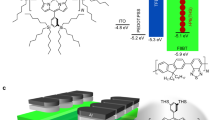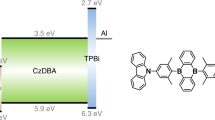Abstract
To obtain the maximum luminous efficiency from an organic material, it is necessary to harness both the spin-symmetric and anti-symmetric molecular excitations (bound electron–hole pairs, or excitons) that result from electrical pumping. This is possible if the material is phosphorescent, and high efficiencies have been observed in phosphorescent1,2 organic light-emitting devices3. However, phosphorescence in organic molecules is rare at room temperature. The alternative radiative process of fluorescence is more common, but it is approximately 75% less efficient, due to the requirement of spin-symmetry conservation4. Here, we demonstrate that this deficiency can be overcome by using a phosphorescent sensitizer to excite a fluorescent dye. The mechanism for energetic coupling between phosphorescent and fluorescent molecular species is a long-range, non-radiative energy transfer: the internal efficiency of fluorescence can be as high as 100%. As an example, we use this approach to nearly quadruple the efficiency of a fluorescent red organic light-emitting device.
This is a preview of subscription content, access via your institution
Access options
Subscribe to this journal
Receive 51 print issues and online access
$199.00 per year
only $3.90 per issue
Buy this article
- Purchase on Springer Link
- Instant access to full article PDF
Prices may be subject to local taxes which are calculated during checkout




Similar content being viewed by others
References
Baldo, M. A. et al. Highly efficient phosphorescent emission from organic electroluminescent devices. Nature 395, 151– 154 (1998).
Baldo, M. A., Lamansky, S., Burrows, P. E., Thompson, M. E. & Forrest, S. R. Very high-efficiency green organic light-emitting devices based on electrophosphorescence. Appl. Phys. Lett. 75, 4–6 ( 1999).
VanSlyke, S. A. & Tang, C. W. Organic electroluminescent devices having improved power conversion efficiencies. (US Patent No. 4539507, 1985).
Baldo, M. A., O'Brien, D. F., Thompson, M. E. & Forrest, S. R. The excitonic singlet-triplet ratio in a semiconducting organic thin film. Phys. Rev. B 60, 14422– 14428 (1999).
Klessinger, M. & Michl, J. Excited States and Photochemistry of Organic Molecules (VCH Publishers, New York, 1995).
Cleave, V., Yahioglu, G., Le Barny, P., Friend, R. & Tessler, N. Harvesting singlet and triplet energy in polymer LEDs. Adv. Mater. 11, 285–288 (1999).
Chen, C. H., Shi, J. & Tang, C. W. Recent developments in molecular organic electroluminescent materials. Macromol. Symp. 125, 1–48 (1997).
Brackmann, U. Lambdachrome Laser Dyes (Lambda Physik, Gottingen, 1997).
Forster, T. Transfer mechanisms of electronic excitation. Discuss. Faraday Soc. 27, 7–17 ( 1959).
Ermolaev, V. L. & Sveshnikova, E. B. Inductive-resonance transfer of energy from aromatic molecules in the triplet state. Dokl. Akad. Nauk 149, 1295–1298 (1963).
Berggren, M., Dodabalapur, A., Slusher, R. E. & Bao, Z. Light amplification in organic thin films using cascade energy transfer. Nature 389, 466–469 ( 1997).
Garbuzov, D. Z., Bulovic, V., Burrows, P. E. & Forrest, S. R. Photoluminescence efficiency and absorption of aluminium-tris-quinolate (Alq 3) thin films. Chem. Phys. Lett. 249, 433–437 (1996).
Vander Donckt, E., Camerman, B., Hendrick, F., Herne, R. & Vandeloise, R. Polystyrene immobilized Ir(III) complex as a new material for oxygen sensing. Bull. Soc. Chim. Belg. 103, 207–211 (1994).
Bulovic, V. et al. Bright, saturated, red-to-yellow organic light-emitting devices based on polarization-induced spectral shifts. Chem. Phys. Lett. 287, 455–460 ( 1998).
Chen, C. H., Tang, C. W., Shi, J. & Klubeck, K. P. Improved red dopants for organic electroluminescent devices. Macromol. Symp. 125, 49–58 ( 1997).
Bulovic, V., Deshpande, R., Thompson, M. E. & Forrest, S. R. Tuning the color emission of thin film molecular organic light emitting devices by the solid state solvation effect. Chem. Phys. Lett. 308, 317 (1999).
Tang, C. W., VanSlyke, S. A. & Chen, C. H. Electroluminescence of doped organic thin films. J. Appl. Phys. 65, 3610– 3616 (1989).
O'Brien, D. F., Baldo, M. A., Thompson, M. E. & Forrest, S. R. Improved energy transfer in electrophosphorescent devices. Appl. Phys. Lett. 74, 442–444 (1999).
Acknowledgements
This work was supported by Universal Display Corporation, the Defense Advanced Research Projects Agency, the Air Force Office of Scientific Research and the National Science Foundation.
Author information
Authors and Affiliations
Corresponding author
Rights and permissions
About this article
Cite this article
Baldo, M., Thompson, M. & Forrest, S. High-efficiency fluorescent organic light-emitting devices using a phosphorescent sensitizer. Nature 403, 750–753 (2000). https://doi.org/10.1038/35001541
Received:
Accepted:
Issue Date:
DOI: https://doi.org/10.1038/35001541
This article is cited by
-
Electroluminescence and hyperphosphorescence from stable blue Ir(III) carbene complexes with suppressed efficiency roll-off
Nature Communications (2023)
-
Phosphorescence resonance energy transfer from purely organic supramolecular assembly
Nature Reviews Chemistry (2023)
-
Critical role of electrons in the short lifetime of blue OLEDs
Nature Communications (2023)
-
Experimental evidence of Förster energy transfer enhancement in the near field through engineered metamaterial surface waves
Communications Physics (2023)
-
Multicolor hyperafterglow from isolated fluorescence chromophores
Nature Communications (2023)
Comments
By submitting a comment you agree to abide by our Terms and Community Guidelines. If you find something abusive or that does not comply with our terms or guidelines please flag it as inappropriate.



